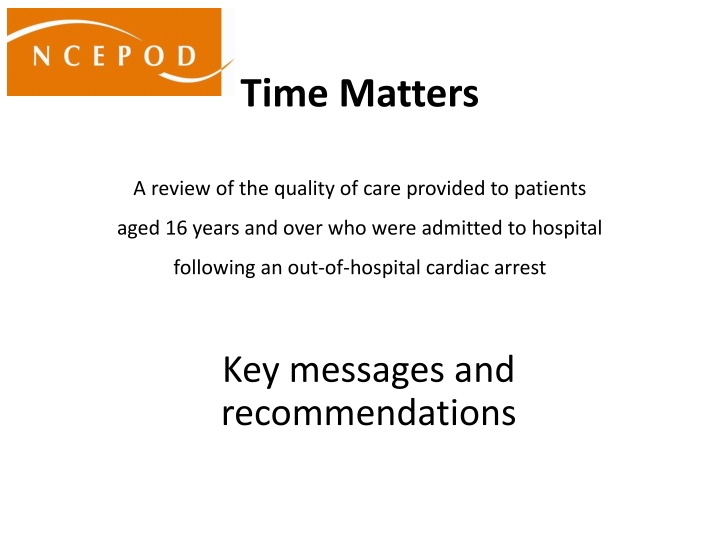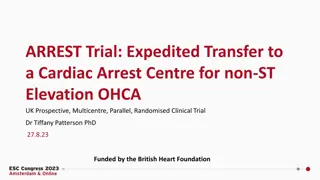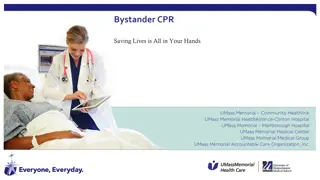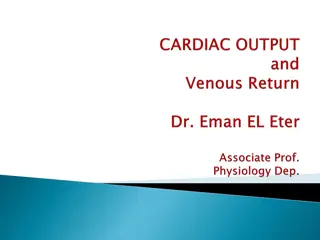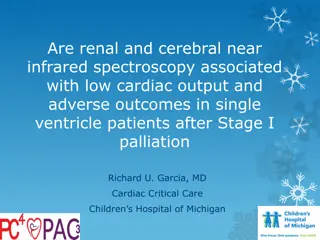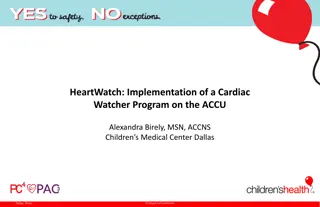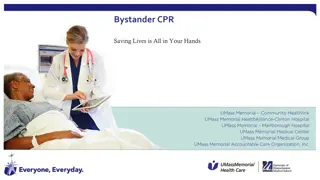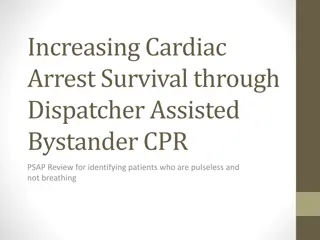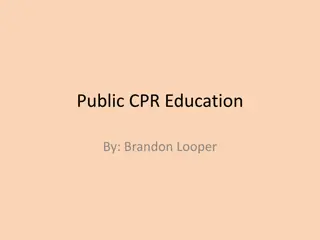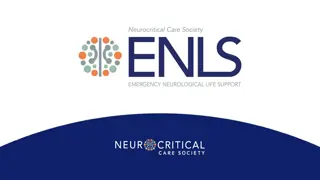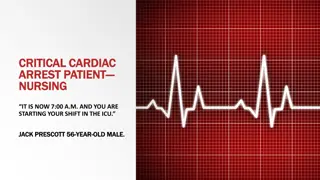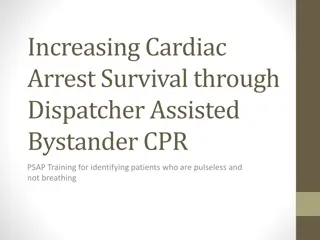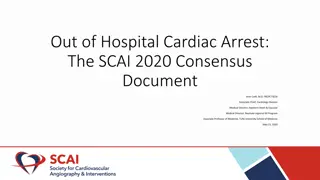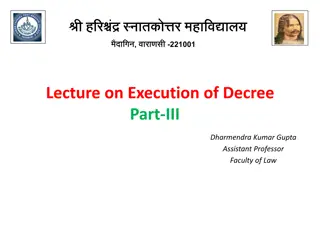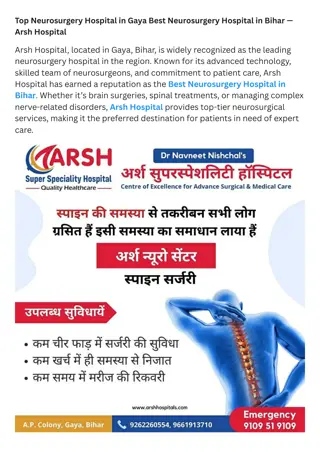Quality of Care for Patients Following Out-of-Hospital Cardiac Arrest
This review focuses on the quality of care provided to adult patients aged 16 years and older who were admitted to the hospital after experiencing an out-of-hospital cardiac arrest. Key messages highlight the importance of strategies for rapid and high-quality resuscitation, documentation of advance treatment plans, and the challenges in predicting survival following cardiac arrest. Recommendations include improving bystander CPR initiatives, standardizing treatment documentation, and allowing time for accurate prognosis assessment. Effective communication across healthcare sectors is emphasized to ensure appropriate decisions are made for patients.
Download Presentation

Please find below an Image/Link to download the presentation.
The content on the website is provided AS IS for your information and personal use only. It may not be sold, licensed, or shared on other websites without obtaining consent from the author.If you encounter any issues during the download, it is possible that the publisher has removed the file from their server.
You are allowed to download the files provided on this website for personal or commercial use, subject to the condition that they are used lawfully. All files are the property of their respective owners.
The content on the website is provided AS IS for your information and personal use only. It may not be sold, licensed, or shared on other websites without obtaining consent from the author.
E N D
Presentation Transcript
Time Matters A review of the quality of care provided to patients aged 16 years and over who were admitted to hospital following an out-of-hospital cardiac arrest Key messages and recommendations
The study A review of the quality of care provided to patients aged 16 years and over who were admitted to hospital following an out-of-hospital cardiac arrest. Organisational questionnaire Clinician questionnaire Case note review
Study population Adult patients (aged 16 years and older) who arrived in hospital after sustaining an OHCA and achieved subsequent sustained return of spontaneous circulation (ROSC) for more than 20 minutes. Exclusions Patients admitted to hospital following an OHCA and ROSC, but where the OHCA was due to trauma, drowning, drug overdose or poisoning. Patients whose cardiac arrest occurred during inter-hospital transfers or on acute NHS hospital premises.
Key messages (1) Bystander Cardiopulmonary Resuscitation (CPR) Ongoing strategies are needed at a population level to ensure that people who sustain an OHCA are treated rapidly with high quality resuscitation, including defibrillation, through a co-ordinated network of accessible and identifiable public access devices.
Key messages (2) Advance treatment plans When advance treatment plans are in place, they should be documented using a standard process (e.g. ReSPECT) to ensure that people receive treatments based on what matters to them and what is realistic. Effective communication between all parts of the healthcare system including, primary care, community services, ambulance services and acute hospitals is then needed to ensure that appropriate decisions are made, irrespective of time or location.
Key messages (3) Prediction of survival No single factor is accurate enough for clinical decision- making at the time of admission to hospital following an OHCA. Time is needed to ensure an accurate assessment of prognosis can be made. Neurological prognosis is particularly difficult to assess, and this should be delayed for at least 72 hours after return of spontaneous circulation.
Key messages (4) Targeted temperature management Elevated temperature is common following an OHCA and is associated with a worse prognosis, but this can be improved by accurate, active temperature control. The current approach in clinical practice appears to be inconsistent and a more active approach is needed.
Key messages (5) Rehabilitation Physical, neurological, cardiac and emotional impairment following an OHCA can all affect quality of survival, and patients benefit from targeted rehabilitation and support. In some areas of the UK there is no provision of these services. These gaps should be closed by local clinical teams and commissioners working together.
Recommendation 1 Implement whole population strategies to increase the rate of cardiopulmonary resuscitation (CPR) by bystanders and the use of public access defibrillators. Target audiences: Public health departments of all UK countries and Crown Dependencies, with support from the Resuscitation Council UK .
Recommendation 2 Put effective systems in place to share existing advance treatment plans (such as ReSPECT*) between primary care services, ambulance trusts and hospitals so that people receive treatments based on what matters to them and what is realistic in terms of their care and treatment. Target audiences: Local commissioners, with support from primary care, ambulance trusts and care home providers * www.resus.org.uk/respect
Recommendation 3 Do not use a single factor such as time to the return of spontaneous circulation, blood lactate or pH to make decisions about organ support or interventions in critical care. No single factor on admission accurately predicts survival after an out-of-hospital cardiac arrest. Target audiences: All clinicians who see patients after an out-of-hospital cardiac arrest and relevant clinical directors
Recommendation 4 Optimise oxygenation for patients with a return of spontaneous circulation as soon as possible after hospital admission, by: Measuring arterial blood gasses Prescribing oxygen Documenting inspired oxygen concentration (or flow rate) and Monitoring oxygen saturation Adjusting inspired oxygen concentration to achieve an arterial oxygenation saturation target of 94 98% Target audiences: All clinicians who see patients after an out-of- hospital cardiac arrest and relevant clinical directors
Recommendation 5 On admission after an out-of-hospital cardiac arrest, prioritise patients for coronary intervention, in line with the European Society of Cardiology current guidelines, because a primary cardiac cause for their cardiac arrest is likely. Target audiences: All clinicians who see patients after an out-of- hospital cardiac arrest and cardiology leads.
Recommendation 6 Use active targeted temperature management during the first 72 hours in critical care to prevent fever (temperature over 37.5oC) in unconscious patients after an out-of-hospital cardiac arrest. Target audiences: Critical care leads and critical care clinical staff See also the Resuscitation Council UK guidelines www.resus.org.uk/library/2015-resuscitation-guidelines/guidelines- post-resuscitation-care#1-the-guidelines
Recommendation 7 Assess neurological prognosis in unconscious patients after an out- of-hospital cardiac arrest, using at least two of the following methods: Clinical assessment Imaging Neurophysiological assessment (including electroencephalogram, to exclude subclinical seizures and improve accuracy) Biomarkers Target audiences: Critical care leads and critical care clinical staff
Recommendation 8 Delay the final assessment of neurological prognosis after an out-of- hospital cardiac arrest until AT LEAST 72 hours after return of spontaneous circulation AND the effects of sedation and temperature management can be excluded. This will ensure a reliable assessment. Repeat the assessment if there is any doubt. Target audiences: Critical care leads and critical care clinical staff See also the Resuscitation Council UK guidelineswww.resus.org.uk/library/2015-resuscitation- guidelines/guidelines-post-resuscitation-care#1-the-guidelines
Recommendation 9 Actively explore the potential for organ donation in all patients after an out-of-hospital cardiac arrest and return of spontaneous circulation, who have a planned withdrawal of life sustaining treatment. Target audiences: Critical care leads and critical care clinical staff *Note the different legal positions in the UK countries
Recommendation 10 Identify all survivors of an out-of-hospital cardiac arrest who would benefit from physical rehabilitation before hospital discharge and ensure this is offered to them. Target audiences: The clinical team caring for the patient after an out-of-hospital cardiac arrest, supported by the physiotherapy service lead
Recommendation 11 Identify all inpatient survivors of an out-of-hospital cardiac arrest who would benefit from cardiac rehabilitation before hospital discharge and ensure this is offered to them. Target audiences: The clinical team caring for the patient after an out-of-hospital cardiac arrest, supported by the cardiac rehabilitation service lead. Commissioners, where these services are not already in place
Recommendation 12 Identify all inpatient survivors of an out-of-hospital cardiac arrest who would benefit from neurological rehabilitation before hospital discharge and ensure this is offered to them. Target audiences: The clinical team caring for the patient after an out-of-hospital cardiac arrest, supported by the neurological rehabilitation service lead. Commissioners, where these services are not already in place
Recommendation 13 Identify all inpatient survivors of an out-of-hospital cardiac arrest who would benefit from psychological intervention before hospital discharge and support and ensure this is offered to them. Target audiences: The clinical team caring for the patient after an out-of-hospital cardiac arrest, supported by the clinical psychology service lead. Commissioners, where these services are not already in place
Time Matters Time Matters Full report, summary and implementation tools can be found at www.ncepod.org.uk/2021ohca.html
